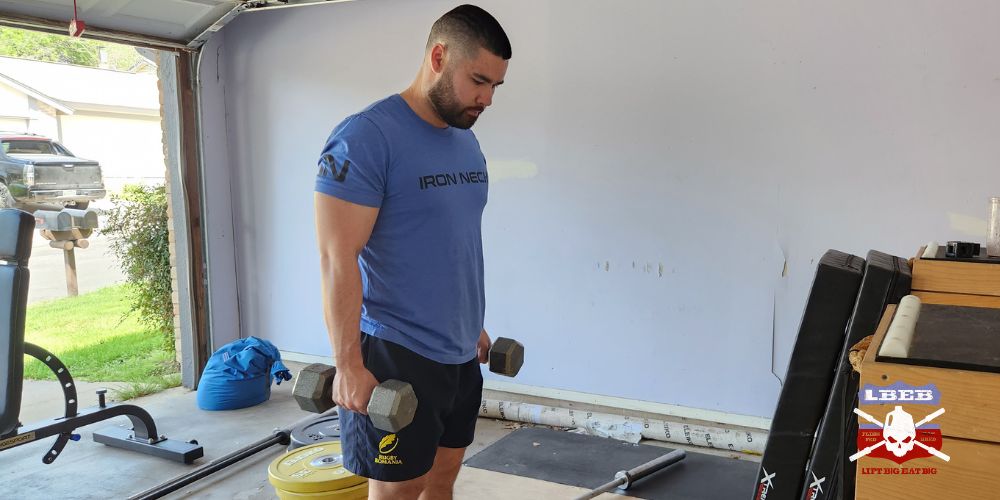You be tempted to blast your biceps daily to get them to grow. It’s a common thought process that keeps many lifters from reaching their potential biceps size. Is there a sweet spot for how often you should train them?
2-3 times per week is optimal for training the biceps for maximum growth. It perfectly balances training and recovery to enhance biceps muscle growth.
So how should those 2-3 days per week look for biceps training? How many sets and reps should you do throughout the week?
Table of Contents
How Often To Train Biceps For Maximum Growth
Training them 2-3 times per week is optimal if you specialize in biceps muscle growth. To do this, you’d run an arm specialization program to reduce the training volume of other muscle groups.
Your training split could include an arm day, back and biceps day, and adding biceps at the start or end of an unrelated muscle group. This would provide 3 days where the biceps are hit intensely for growth.
However, 2 days per week is more than enough to get bigger biceps.
How Many Sets Of Biceps Per Week?
At least 10 sets of biceps per week is needed to maximize biceps growth [2]. Research suggests a rate of muscle gain of 9.8% when performing 10+ sets compared to 6.6% for 5-9 sets and 5.4% for less than 5 sets per week [2].
While we don’t have direct evidence that exceeding 10 sets will promote further muscle gain, there is a dose-response relationship between volume and hypertrophy [2]. Meaning the more working sets performed, the greater the hypertrophic response, to a certain extent.
For example, there is a 0.37% increase in muscle mass on average with each additional set performed [2].
What is the upper limit? 15-20 sets per week is categorized as high volume, and 20-25 sets are considered overreaching [3]. 25-30 sets veers into overtraining territory but can be used sparingly within a high-volume training cycle. Therefore, varying your training cycles to perform 10-30 sets of biceps per week will maximize muscle growth.
How Many Sets Of Biceps Per Workout?

Performing 10 sets of biceps in one workout is fine. But doing 25 sets in a single workout is doing you more harm than good. The American College of Sports Medicine recommends 1-3 sets per exercise for beginners and 3-6 sets per exercise for advanced trainees within a workout [1].
It is suggested to limit the total number of sets for biceps to 10 sets per session [4]. This will give you the best training quality as exercises placed last in a session diminishes strength gains in the long term [5].
How Often Do Bodybuilders Train Biceps?
How often bodybuilders train their biceps depends on their weak body parts. A typical bodybuilding split will have you training biceps twice a week. Once on back and biceps day and once during an arm day.
This can change depending on how much back work you are doing. If you train back 2-3 times per week, you may only train biceps once directly.
Will Training Biceps Everyday Make Them Bigger?

It’s a common misconception that more is always better. Lift more often, and you’ll accelerate muscle gain. But unfortunately, gaining muscle doesn’t work like this. Muscle is built when you’re recovering between gym sessions.
Therefore, training your biceps every day won’t allow for adequate recovery. Being under-recovered means reduced training quality, further diminishing your muscle-building ability.
Do Biceps Respond Better To High Reps?
Using a variety of rep ranges is always advantageous when building biceps. Using rep ranges across the spectrum (6 – 20 is the sweet spot for biceps, in my experience) may provide an even better muscle-building response than sticking to a small rep range [6].
How would this look within a workout? You may start with a heavier, low-rep biceps exercise like the barbell curl for 6-10 reps. Follow that with a moderate load, moderate rep exercise like the hammer curl for 10-12 reps.
Then you can finish blasting your biceps with reverse curls or a stretching biceps exercise like the incline DB curl for 12-15 reps or more.
This is one example of the many combinations you can use.
Summary
Train your biceps 2-3 times per week to maximize growth with a maximum of 10 sets per workout on average. This will allow a balance between training and recovery, so you reduce your risk of injury and burnout. Cycle your volume between the 10 – 30 set range with a variety of rep ranges.
References
1. American College of Sports Medicine. (2009). American College of Sports Medicine position stand. Progression models in resistance training for healthy adults. Medicine and science in sports and exercise, 41(3), 687-708.
2. Schoenfeld, B. J., Ogborn, D., & Krieger, J. W. (2017). Dose-response relationship between weekly resistance training volume and increases in muscle mass: A systematic review and meta-analysis. Journal of sports sciences, 35(11), 1073-1082.
3. Schoenfeld, B., & Grgic, J. (2018). Evidence-based guidelines for resistance training volume to maximize muscle hypertrophy. Strength & Conditioning Journal, 40(4), 107-112.
4. Schoenfeld, B., Fisher, J., Grgic, J., Haun, C., Helms, E., Phillips, S., … & Vigotsky, A. (2021). Resistance training recommendations to maximize muscle hypertrophy in an athletic population: Position stand of the IUSCA. International Journal of Strength and Conditioning, 1(1).
5. Nunes, J. P., Grgic, J., Cunha, P. M., Ribeiro, A. S., Schoenfeld, B. J., de Salles, B. F., & Cyrino, E. S. (2021). What influence does resistance exercise order have on muscular strength gains and muscle hypertrophy? A systematic review and meta-analysis. European journal of sport science, 21(2), 149-157.
6. Schoenfeld, B. J., Grgic, J., Van Every, D. W., & Plotkin, D. L. (2021). Loading recommendations for muscle strength, hypertrophy, and local endurance: a re-examination of the repetition continuum. Sports, 9(2), 32.
